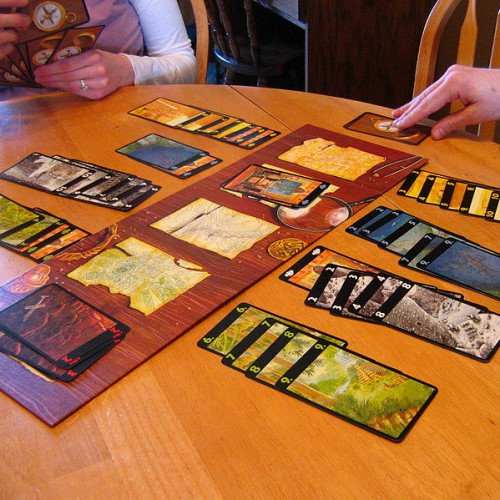LOST CITIES VS SHATAR

LOST CITIES
Lost Cities is a 60-card card game, designed in 1999 by game designer Reiner Knizia and published by several publishers. The objective of the game is to mount profitable expeditions to one or more of the five lost cities (the Himalayas, the Brazilian Rain Forest, the Desert Sands, the Ancient Volcanos and Neptune's Realm). The game was originally intended as a 2-player game, but rule variants have been contributed by fans to allow 1 or 2 further players, causing Reiner Knizia himself to later provide semi-official 4-player rules. Lost Cities is a fast-moving game, with players playing or discarding, and then replacing, a single card each turn. Cards represent progress on one of the five color-coded expeditions. Players must decide, during the course of the game, how many of these expeditions to actually embark upon. Card-play rules are quite straightforward, but because players can only move forward on an expedition (by playing cards which are higher-numbered than those already played), making the right choice in a given game situation can be quite difficult. An expedition that has been started will earn points according to how much progress has been made when the game ends, and after three rounds, the player with the highest total score wins the game. Each expedition that is started but not thoroughly charted incurs a negative point penalty (investment costs). Interaction between players is indirect, in that one cannot directly impact another player's expeditions. However, since players can draw from the common discard piles, they are free to make use of opposing discards. Additionally, since the available cards for a given expedition are finite, progress made by an opponent in a given color can lead to difficulty making progress in that same color. The game's board, while designed to supplement the theme, is optional and consists only of simple marked areas where players place discards. If Lost Cities had four expeditions instead of five, it could be played with a standard deck of playing cards. When doing so, the face cards would represent investment cards, with numbered cards two through ten serving as the expedition progress cards.
Statistics for this Xoptio

SHATAR
Shatar (Mongolian: ᠮᠣᠩᠭᠣᠯ ᠰᠢᠲᠠᠷᠠ Monggol sitar-a, "Mongolian shatranj"; a.k.a. shatar) and hiashatar are two chess variants played in Mongolia. The rules are similar to standard chess; the differences being that: The noyan (ᠨᠣᠶᠠᠨ, lord) does not castle. The küü (ᠬᠦᠦ, pawn) does not have an initial double-step move option, except for the queen pawn or king pawn. In old shatar rules, a pawn that reaches its eighth rank must promote to half-power tiger. But a pawn could step back to its sixth rank to promote to all-power tiger. It moves like a queen. The baras (ᠪᠠᠷᠰ or ᠪᠠᠷᠠᠰ, tiger; Persian: fers) moves like a promoted rook in shogi: like a chess rook or one square diagonally. It was called half-power tiger or half-power lion in old shatar rules. In modern shatar rules, a baras moves like a queen. The mori (knight; ᠮᠣᠷᠢ) cannot deliver mate. In modern shatar rules, the mori can give mate. The bishop (teme) and rook (terge) move as they do in standard chess. The game always starts by White playing 1.d4 and Black responding with 1...d5. This is the only time in the game a pawn may advance two squares; some sources claim this initial move can optionally be made with the e-pawn. In old shatar rules, Ujimqin player must make an initial double-step move with the queen pawn; in Chahar, the king pawn. In old shatar rules, baremate is draw. In old shatar rules, one special rule is called tuuxəi, like komi in Go. A player could leave the enemy with only two pieces remaining (noyan and another piece) at the end. Then he must start making checks using the terge or baras and make consecutive checks until checkmate. Before checkmate, number of consecutive checks is the number of tuuxəi. If a player wins by checkmate as in chess, he receives only one tuuxəi. A player usually leaves the enemy with one noyan and one küü to allow time to put his pieces into good positions for making consecutive checks.